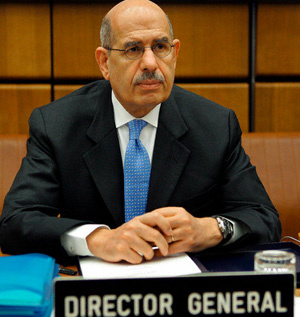Iranian Diplomacy’ Analysis on Muhammad Elbaradei’s Gray Report
Once again Elbaradei has released a gray report, which will be used by both Iran and its opponents, to carry on their plans

Chairman of IAEA, Muhammad Elbaradei, delivered his 11-page report on Iran’s nuclear dossier to 35 members of the Board of Governors. Although this report officially has been handed only to members of the board, but many news agencies have published their analysis on this report which provides a detailed picture of Iran’s nuclear status in 58 paragraphs.
The main body of the report concerns the remaining problems in the nuclear dossier. According to the last summer agreement between Iran and IAEA, the agency would put forward all its questions about Iran’s past nuclear activities and the Islamic Republic of Iran would be committed to answer all these questions to clarify its past activities once and forever.
Therefore, in the past few months, intensive negotiations between Iran and IAEA experts took place in which, in addition to providing information on questions, the agency inspectors visited different parts of the country and interviewed certain individuals.
In Elbaradei’s report of November 15th 2007 to Board of Governors, some of the remaining issues, including P1 and P2 centrifuges were regarded as concluded. In the last report of IAEA Chairman, other issues were investigated and Elbaradei clearly stated that Iran has shown further clarity and transparency about its nuclear activities and IAEA has reached the conclusion that Iran’s answers correspond with agency’s findings. Therefore IAEA doesn’t consider them as remaining problems anymore. In other words, issues such as Polonium 210 test and Gachin Mine are considered as ended.
In his report, Elbaradei has also addressed the Green Salt project that has been mentioned by the United States, and has regarded it as one of the remaining problems. From Iran’s point of view this is not acceptable, since based on the agreement made between Iran and IAEA, claims made by other countries weren’t included among the 6 remaining problems.
While at the start of negotiations IAEA spoke of only 6 remaining problems, which have been solved now, in his recent report Elbaradei has called the aforementioned alleged studies as a major remaining problem. Referring to Iran’s claim on invalidity of this allegation, he has demanded Iran to cooperate actively with IAEA on this matter. Also in this report enrichment activities have been addressed and regarded as opposed to the decisions of the Security Council.
Another passage of Chairman’s report concerns the additional protocol. Like his previous reports, Elbaradei has seriously demanded Iran to enforce this protocol. He has concluded that without enforcement of this protocol and before receiving Iran’s explanations on alleged studies, he can’t talk about nuclear activities and material with certainty.
The question is why Elbaradei hasn’t explicitly mentioned end of doubts on remaining problems? America and its allies who were aware of content of the report before its release and knew that they couldn’t find anything negative about the 6 issues, launched a heavy political propaganda against Iran to influence Elbaradei so that he wouldn’t merely point to positive outcomes in his report.
At first, the United States announced that it will hand IAEA the information it possessed on alleged studies so that IAEA would discuss that with Iran. Next, France entered the scene and asked Elbaradei not to be soft with Iran. Israeli officials also remarked that Iran will take advantage of IAEA’s report. That’s the reason Elbaradei had to arrange his report in the present form to set a balance.
And now in such circumstances France and Britain introduced a new draft for a sanction resolution against Iran in the Security Council. 5+1 representatives gathered in Washington yesterday to negotiate about this draft.
The United States and its allies want this draft to be put on vote on Friday 26th of February. They are determined to pass the resolution before IAEA Board of Governors meets on 3rd of March in Vienna. They are worried if the prevailing air in that meeting tends towards Iran and puts them into trouble in New York.
America’s strategy stresses Iran’s non-compliance with previous resolutions. Definitely parts of Elbaradei’s report, such as those which concern alleged studies as a remaining problem and the necessity of enforcing additional protocol will be used by the United States.
On the other hand, Iran who views Elbaradei’s report as a proof for its truthfulness emphasizes end of questions on remaining problem and peacefulness of its previous activities. Addressing November 2007 report of NIE on non-military nature of Iran’s nuclear activities, Iran doesn’t consider the Security Council’s interference in its nuclear case as legitimate.
Here China and Russia on one hand and NAM states of Security Council on the other hand have a crucial role in approval or rejection of the resolution. The United States claims that it possesses enough votes to pass the resolution.
Around one month ago 5+1 countries announced their approval with release of the new resolution. Since then the Kosovo crisis has led to a confrontation between Russia and America. Does a Russia incensed with America’s stance on Kosovo’s independence block the approval of this resolution or it’ll get more privileges from the United States in a political deal?
Will China change its opinion about the resolution based on Elbaradei’s report? Do NAM countries of the Security Council have enough power and motive to stand against pressures of the United States and its European allies?
We will find the answer to these questions in a few days time. But what is obvious is that Elbaradei’s report, although it contains many positive points for Iran, can be used by Iran’s opponents in the Security Council.

